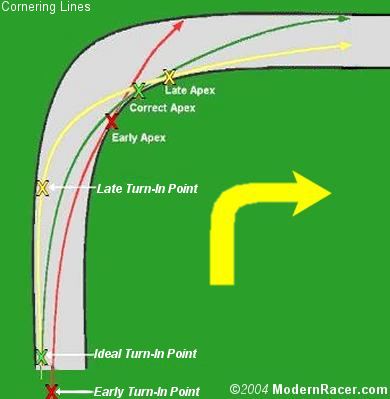Taking a car around a corner is more than just turning the steering wheel, especially in competition driving. When throwing a car around a curve at breakneck speeds, the line taken when entering and exiting the turn makes a lot of difference.

There is a certain procedure to be followed when approaching a corner on the track at high speed. While driving in a straight line, when you see a corner ahead, smoothly lift off the throttle. You will learn to do this as late as possible with practice. Now progressively apply the brakes as needed while still in a straight line. Quickly downshift to the right gear to maintain enough revs for accelerating out of the turn. While looking ahead to the apex of the curve, smoothly release the brakes just before you turn-in. Braking during the actual turn may upset your car's balance. Gently apply a little throttle as you start the turn-in. As you turn, always look further ahead into the turn by physically turning your head. Always turn the wheel slowly and smoothly, as jerky steering movements will also upset the car's balance. Co-ordinate your hands and eyes, for progressive steering input. As you pass the apex of the turn, smoothly apply more throttle in a progressive manner, and begin your move towards the outer edge of the track as you exit the turn. Let the steering wheel smoothly and progressively unwind towards the trackout point, by which time your wheel should be pointing straight ahead.
In a constant radius corner, if you turn in at the correct point and start with the correct amount of steering input, you can keep the steering wheel at the exact same position through the whole turn and your car will travel in an arc from the turn-in point, through the apex and to the exit point.

With respect to navigating the turn, there are various lines you can take, but only one line which is the most beneficial. The best line to take largely depends on driver skill. The diagram above demonstrates three methods of entry and their potential consequences on exit.
The early apex, as shown by the red line, is quite the wrong method of negotiating a turn. You get a fast entry speed into the turn but safely exiting the turn becomes harder. Early apex usually have an early turn-in point where you start your turn away from the outside edge of the track and move towards the center. Entering the turn too fast is always a sign of driver error, and the troubles get worse especially with cars that have a tendency to understeer. The result is that a very sharp turn is required for the exit, which may be unsettling for the car and the driver may instead go off the track.
The late apex, as shown by the yellow line, is a safe method, good for beginner track-drivers but it is not the fastest way through a turn. This technique involves driving past the ideal turn-in point and then making a hard turn into the corner at a relatively slow speed. After hitting the late apex, the exit is very easy for the driver and does not require driving to the outside of the track. This minimizes the chances of an inexperienced driver going off the track, and exit speeds are quite fast.
The ideal apex, as shown by the green line, is a good balance between a fast entry and a fast exit. The turn is started from the outside edge of the track and the car hits the midpoint of the turn on the inside edge. Finally, one tracks-out to the outside edge of the track for a fairly fast exit.
The key to safe turning at the track is to follow the old saying "slow in, fast out." Enter a turn slowly to avoid getting into trouble, and speed up as you are exiting the turn heading for a nice and straight piece of asphalt. To drive at the limit of of your tires' traction, it is important to turn-in, apex and track-out at the precise points. With practice at slower speeds, you can learn to drive along the proper line through every corner, so you get used to the idea of "clipping" the apex.
Modernracer.com © 2004